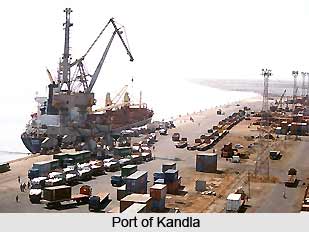 Kandla Port, a national port, is one of the eleven most important ports of India. This port is situated on Kandla stream. The first investigation of this stream was undertaken by the British Royal India Navy in 1851 and a detailed survey done in 1922. This port is developed by Joint project of Maharao Shree Khengarji-III and British Government in the 19th century.
Kandla Port, a national port, is one of the eleven most important ports of India. This port is situated on Kandla stream. The first investigation of this stream was undertaken by the British Royal India Navy in 1851 and a detailed survey done in 1922. This port is developed by Joint project of Maharao Shree Khengarji-III and British Government in the 19th century.
Kandla port came into existence in the year 1931 with a single Peir construction. Later on with the loss of Karchi port to Pakistan during partition, after independence the government of India chose Kandla as an ideal sea outlet. Thus the Kandla Port was developed and since then Kandla port has played a pivotal role in enhancing country`s maritime trade. Standard dry cargo treatment capacity of Kandla Port is 24,000 metric tons per day. The port is under Ministry of Commerce and is managed by a Port Trust with a Chairman as its head.
Kandla Port Trust is run by a board of trustees. There is an administrator - representative of the ministry of Commerce - appointed for the management of a free trade zone known as the Kandla Free Trade Zone placed near the port where hundreds of small and international companies are also sited. Owing to fast progress of Kandla port close city like Gandhidham also developed faster. Kandla port plays a major role in the country`s international trade. Having notched up a string of success, it has emerged as a forerunner, and has carved a niche for itself, by its steady growth and economy of operations.
Kandla port is well equipped with infrastructural. It has 10 berths, 6 oil jetties, 1 maintenance jetty, 1 dry dock and small jetties for small vessels, which can accommodate from large to small vessels. Near all these terminals and jetties there are storage facilities for cargo from containers to petroleum. The port is also outfitted with Sixteen Wharf cranes. Apart from this, the port also provides for additional facilities for international traders. Due to its strategic location it is the connecting hub for Northern, Western and Central India. Kandla also has the country`s only Free Trade Zone Kandla Port, the foundation stone for which was laid by Pandit Jawaharlal Nehru, has 1800 metres of dry cargo berths where in a straight line, ten ships could easily be accommodated. It has berths for a tanker also where chemicals, vegetable oil etc are handled. Kandla today has become the hub of India`s foodgrains and oil imports.
Kandla Port is a self sufficient, self enhancing Port. It is also among the highest revenue earning Port of India. The Port is the nearest, most economical and most convenient for handling imports and exports of the highly productive granary and industrial belt stretching across Jammu & Kashmir, Punjab, Himachal Pradesh, Haryana, Rajasthan and Gujarat. Kandla Port is the most economical major port in terms of tariff and operational expenditure. The efficiency and all requisite user facilities nevertheless confirm to international standards. The Port is up to date with the latest technological innovations. Happy labour-management relations and economical handling of heterogeneous cargo is considered the key element to the success of the Port of Kandla.
Kandla Port has floated a global tender for a two-year capital dredging contract of 20 million cubic metres at an estimated cost of Rs 100 crore. Kandla Port attained new levels of performance in fiscal 2006-07, establishing a new record by handling a cargo volume of 52.98 million tonnes, in the process entering into the select league of ports that have registered a throughput of 50 million tonnes or more.






